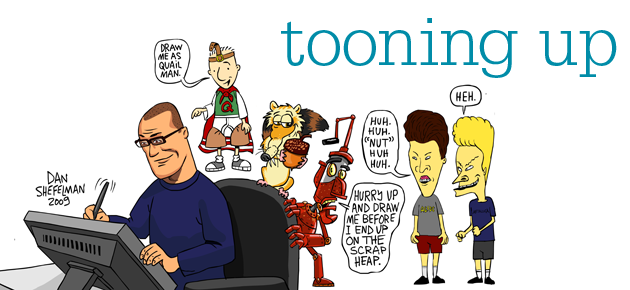Volume 31 Number 4 Spring/Summer 09
In this Issue
Features
- Family Squabbles
- Confronting Conformity
- Caution, Not Crisis
- Tooning Up
The Editor's Page
- Boiling Points
- Letters to the Editor
Along Middle Path
- Moon Walking at Philander's Phling
- Nayef Samhat Appointed Provost
- In and Out at Kenyon
- Kenyon in the News
- The Hot Sheet
- A Stitch in Time for Winter
- Gambier is Talking About...
- Sound Bites
- What's your Kenyon Quotient?
Sports
- Imagine
- Sports Round-Up
Books
- How the South Won
- Reviews
Office Hours
- Kenyon bids farewell to four veteran professors
- Transformed by time
- Not in my Job Description: Radio Nights
- Burning Question for Jay Corrigan, Associate Professor of Economics
Alumni News
- Sparking Sparks
- Singing from the Roots
- Obituaries
- Alumni Digest
The Last Page
- Un-Kenyon
- The Back Cover

By Mark Ellis
Somewhere between the lines of Sid the ground sloth in Ice Age and the singing, dancing cockroaches of Joe's Apartment lurks the fine hand of Dan Shefelman '84.
The Texan who left Kenyon and took a job as an editorial cartoonist with his hometown newspaper, the Austin American-Statesman, now works out of his home in Westchester, New York, from where he has pulled the strings of cartoon characters with wider fame than his own. His political cartooning took him from Texas to Newsday in New York City. His collaboration with Blue Sky Studios led to storyboard work on feature films Ice Age and Robots. He has put the punch in MTV's Celebrity Death Match and boggled the brains of Beavis and Butt-Head.
The Mad genius (yes, he created a character for the subversive humor magazine he prized as a child) has played a role in mainstream family fare and offbeat cult classics. A lively family life informs his wit. He and his wife, Jane Reiss '83, have two children--Lena, sixteen, and Will, thirteen. Reiss is the chief marketing officer for NYC & Company, the city's marketing, tourism, and partnership organization.
The Alumni Bulletin caught up with Shefelman recently between storyboards.
Bulletin: Major newspaper political cartoons. Animated film work. And the biweekly, animated political cartoon Red and Blue on CNN.com. That may be a unique career arc. Are you the most accomplished cartoonist people have never heard of?
Shefelman: Yes. I've worked in some very public positions, where I'm the signature on the bottom of the page and in the credits at the end of the film. That's being very out front. And then there are different roles an animator plays in films and you sort of become part of this big, incredible machine and, in that sense, you're more anonymous. I go back and forth between the two.
Bulletin: Is fame a goal?
Shefelman: Well, of course, fame is a big part of the business and it's fun. Cartoonists are entertainers. The idea is to get a crowd gathered around laughing and engaged in your work.
Bulletin: Kenyon enjoyed a run of talented cartoonists in the 1970s and '80s. Tim Newcomb '74 has had a long run as a political cartoonist in Vermont. Jim Borgman '76 won the Pulitzer Prize and draws the comic Zits. Bill Watterson '80 created Calvin and Hobbes. Was there ink in the water?
Shefelman: My brother (Karl '80) was a swimmer here. Karl sent home copies of the Collegian, and I would read Watterson's "Mucous and Fester," about dorm life. It was really dumb fun. Borgman at the time was an up-and-coming editorial cartoonist and I admired his work. I loved to watch the way those two put ideas together and I admired their draftsmanship. I felt I needed to be at Kenyon because there was something special going on. I sort of understood that cartooning was as much about learning to think as it was about learning to draw.
Bulletin: You were on the swimming team?
Shefelman: Jim Steen has a great tradition here, and I was proud to be part of it. I loved the clarity of striving for maximum speed, but the daily grind felt confining. I quit sophomore year and joined the water polo club team. I thrived on the teamwork and the one-on-one with opponents. There's a parallel with my career, which has been a process of creating in intense isolation and then going out into these team endeavors of animation productions and mixing it up and being inspired by creative people.
Bulletin: You started in newspapers. What did you learn?
Shefelman: I learned to make a deadline, to create under pressure. Knowing a cartoon has to run in the paper every day can be scary. You spend most of your time chewing your fingers, hiding under your desk, not coming up with anything. The trick is to be able to remain playful and keep searching ... doodling images until an idea forms. That's the moment you live for.
Bulletin: Newsday is a big newspaper stage in New York. Was that the attraction?
Shefelman: New York itself is an incredible stage. It's a cartoonist's dream. New York City was my beat. New York is bare knuckles. It's scrappy and honest. Nobody holds back. Ed Koch was the mayor and he was my target. And he could throw it right back. I never worried about giving him my best shot.
Bulletin: You evolved into animation?
Shefelman: I had a love-hate relationship with the daily news cycle. I was looking for a creative career where I could shape the evolution of ideas. Animation is a months--and years--long process of building up, tearing down, and building back up until the film takes shape. So I took the leap. My first job in animation was drawing a hat on Porkchop the dog in [the animated television show] Doug. I became a jack-of-all-trades in animation and, more and more, I gravitated to storyboarding.
Bulletin: Do you identify yourself as a cartoonist?
Shefelman: I consider myself a storyteller above all. Political cartoons and animation consist equally of visual and verbal storytelling.
Bulletin: Explain the mystery of the storyboard.
Shefelman: In Ice Age, we were working with a script, but we were still forming the characters' personalities. The script and the voice actor give the first breaths of life, but the character is fully realized in the storyboard process. We storyboard an entire scene, then scan it on the computer, and lay down temporary voice and sound effects. This allows us to watch a filmstrip of the movie before 150 artists spend eighteen months designing and animating. It's a fluid process.
Bulletin: Is there a scene that you created that sticks with you?
Shefelman: The cave-painting scene in Ice Age is one of my proudest achievements. It's a pivotal emotional moment for all of the characters, and the challenge was to present the loss of Manny the Mammoth's family in a way that was emotionally devastating, inspiring, and yet not too terrifying. I pulled it off, but only after two months of soul searching, drawing and re-drawing the scene. I found myself going through wrenching feelings about my own family and how unfathomable such a loss would be. There were a lot of teary eyes in the room when I pitched the storyboard for that scene. But it was very satisfying to throw in a couple of well-timed jokes. After hearing Manny's painful story, Sid wipes his nose and rubs it on Diego the saber-toothed tiger, who gives him a predatory look. There's something powerful about laughing through tears.
Bulletin: Do you have favorite characters?
Shefelman: Without a doubt that would be Red and Blue. They are entirely my own creation. Although it is always an adventure to be involved in the development of characters created by others, nothing compares to creating your own characters from conception.
Bulletin: Red and Blue are animated man and wife, on different sides of the political spectrum. The strip on CNN.com included appearances by Barack Obama, George Bush, Sarah Palin, and Wolf Blitzer, among others. Is that your voice I hear for those characters?
Shefelman: I don't think I'm the best impressionist out there. You can get away with murder if you have a good drawing. I love doing everything on these cartoons. Because of the need for a fast turn-around in the Web news cycle, which is about sixty seconds, I have to do things very quickly. Writing, design, voice acting, animation, sound effects, and music. It's incredibly satisfying to orchestrate all these media under one roof.
Bulletin: Where do you draw the line between hand and computer?
Shefelman: These days, it's hard to tell where the hand-drawn aspect of my work ends and the computer begins. You could say I am joined at the fingers to the computer. I draw on a digital tablet with a digital pen--so the process is the same as drawing on paper but it is recorded as a digital image. Many artists find this repugnant. No originals! I understand that, but I feel that this is a more direct connection between what's in my head and what becomes "real" on the screen.
Bulletin: You were part of teams that were nominated for Academy Awards for Ice Age in 2002 and the short film Gone Nutty in 2003. Did you walk down the red carpet in Los Angeles?
Shefelman: No. And we didn't win, but the sense of pride at being nominated is something the whole crew takes to heart. More important is hearing people talk about our movies and how alive the characters are for them.
Bulletin: You worked on Doug and King of the Hill, both pretty wholesome animated series.
Shefelman: On Doug, I was the design director. I designed the look of the show. King of the Hill was strictly storyboarding, just figuring out the action. The writing is so brilliant and subtle.
Bulletin: You also worked on the MTV film Beavis and Butt-Head Do America. Some people associate the boys with the decline of Western civilization.
Shefelman: I was offered a job to work on the TV show early on. I watched a few episodes and felt it sent a bad message--sort of negative, decadent stuff. I turned it down. But I soon realized that I was missing the point in the same way that people who see Bart Simpson as a role model miss the point. The role model who I think is more important is a creator like Mike Judge, who maintains the integrity of an idea. If you are going to do a show about two idiots, don't pull any punches. Let them be incredible caricatures of idiots. They're teenage Larry Davids. When MTV decided to make the movie, I jumped at the challenge of bringing the two idiots to the big screen.
Bulletin: What are you working on?
Shefelman: I'm actually forming a company, called the Story Team. Putting together a team of storyboard artists for a movie is very tough. I've assembled some very talented artists. They have strengths in character, humor, story structure, action, and emotion. A studio can hire us, and we will handle the whole creative pre-production of the film.
Bulletin: Next film?
Shefelman: Several of us from the Story Team are working for Lumenas Animation Studios on a movie called The Legend of Santa Claus.
Bulletin: I think that's been done.
Shefelman: Not this way.
Bulletin: A word of advice for the next Kenyon cartoonist?
Shefelman: Study everything that interests you. Go to the Economics Department. Take art and drama. Study religion. Study political science. Study English. Do something with your hands involving form and shape and design. Do things that scare you. And have fun.
Gambier, Ohio 43022
(740) 427-5158

 To find out more about Shefelman's work,
To find out more about Shefelman's work,  Delicious
Delicious Facebook
Facebook StumbleUpon
StumbleUpon Digg
Digg reddit
reddit